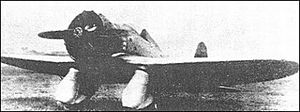Mitsubishi 1MF10
 From Wikipedia the free encyclopedia
From Wikipedia the free encyclopedia
| 1MF10 | |
|---|---|
 | |
| Mitsubishi 1MF10 | |
| Role | Fighter aircraft |
| National origin | Japan |
| Manufacturer | Mitsubishi Kokuki KK |
| Designer | Jiro Horikoshi |
| First flight | March 1933 |
| Status | Prototype |
| Number built | 2 |
The Mitsubishi 1MF10 or Mitsubishi experimental 7-Shi carrier fighter (七試艦上戦闘機) was a prototype Japanese monoplane single-seat carrier-based fighter aircraft of the 1930s. Two were built for the Imperial Japanese Navy, but both were lost in crashes, with no production following.
Design and development
[edit]In April 1932, the Imperial Japanese Navy issued a specification for a replacement for its current carrier-based fighter, the Nakajima A2N, asking for designs from both Mitsubishi and Nakajima. Unlike the biplane which was to be replaced, both competitors submitted monoplanes, with Nakajima offering a version of its Type 91 parasol-wing fighter, already in production for the Japanese Army. Mitsubishi assigned design of its contestant to a team led by Jiro Horikoshi, which created the first low-wing cantilever monoplane to be designed in Japan, the Mitsubishi 1MF10.[1][2]
The 1MF10 was of all-metal construction, with a monocoque duralumin fuselage, with duralumin wing structure covered in fabric, with the pilot accommodated in an open cockpit. The aircraft was powered by a Mitsubishi A4 two-row 14-cylinder radial engine driving a two-bladed propeller. It had a fixed tailwheel undercarriage.[1][2]
The first prototype 1MF10, with the Navy designation Experimental 7-shi Carrier Fighter[a] made its maiden flight in March 1933.[1] It was destroyed in July 1933 when its tail broke up during diving tests, although the pilot escaped by parachute. The second prototype had a revised undercarriage, with the main wheels and undercarriage legs faired into streamlined spats. It was also destroyed in a crash, when it could not be recovered from a flat spin in June 1934 by pilot Motoharu Okamura.[1][2]
Although the design was advanced, it was rejected by the Japanese Navy, having poor handling[1] and not meeting the performance requirements of the specification.[2] It did form the basis of more advanced designs, however, with Horikoshi using elements of it such as the box-spar in the later successful Mitsubishi A5M fighter of similar layout.[4]
Specifications
[edit]Data from Japanese Aircraft 1910–1941[5]
General characteristics
- Crew: 1
- Length: 6.92 m (22 ft 8 in)
- Wingspan: 10 m (32 ft 10 in)
- Height: 3.31 m (10 ft 10 in)
- Wing area: 17.70 m2 (190.5 sq ft)
- Empty weight: 1,225 kg (2,701 lb)
- Gross weight: 1,578 kg (3,479 lb)
- Powerplant: 1 × Mitsubishi A4 14-cylinder air-cooled radial engine, 580 kW (780 hp)
Performance
- Maximum speed: 320 km/h (199 mph, 173 kn) at 3,000 m (9,800 ft)
- Endurance: 3 hr
Armament
- Guns: 2× 7.7 mm machine guns[2]
See also
[edit]Related development
Aircraft of comparable role, configuration, and era
- Curtiss P-36
- Hawker Hurricane
- Heinkel He 70
- Heinkel He 112
- Messerschmitt Bf 109B
- Nakajima Ki-27
- Polikarpov TsKB-12
- Seversky P-35
- Supermarine Spitfire
Appearances in media
Notes
[edit]References
[edit]- Green, William; Swanborough, Gordon (1994). The Complete Book of Fighters. New York: Smithmark. ISBN 0-8317-3939-8.
- Mikesh, Robert C.; Abe, Shorzoe (1990). Japanese Aircraft 1910–1941. London: Putnam Aeronautical Books. ISBN 0-85177-840-2.